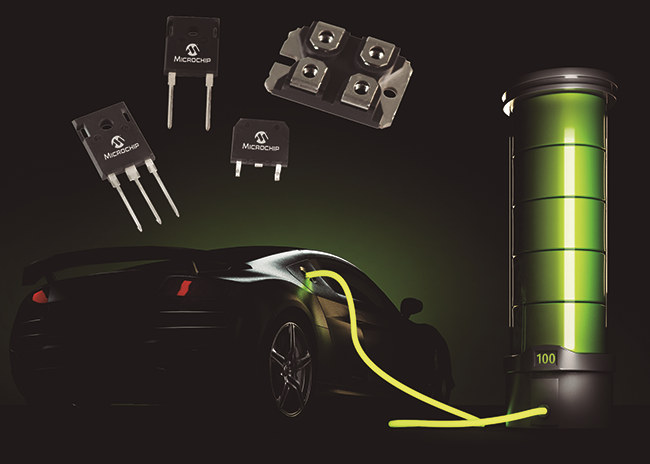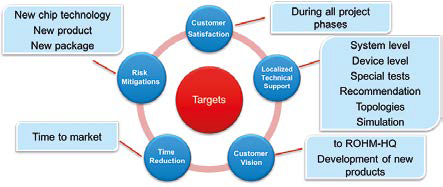Transport affects people's lives every day, moving people and goods from one point to another. Trains, in particular, are subjected to various weather systems that can influence the electronics used in them. Therefore, it is important that conveyor system developers take into account parameters that are not usually presented in data sheets. This is even more important in the case of broadband power electronics, such as silicon carbide (SiC), which is a novel material in this type of application.
Microchip Technology's SiC power devices are rugged, robust and suitable for demanding applications within the transportation segment. A robust portfolio of standard and custom package options offers customers design flexibility. Programmable digital gate drivers, available as plug-and-play printed circuit board (PCB) drivers or core drivers, provide engineers with tools to optimize system performance and match the application with minimal hardware modifications.
The resistance of SiC MOSFETs over a wide range of conditions is essential for auxiliary power units (APUs) that power both conventional and emergency loads. The following should be checked for 1) the stability and lifetime of the gate oxide of the MOSFET; 2) the stability of the diode of the body of the MOSFET; and 3) measures of resistance to failures, such as avalanche resistance.
MOSFET Gate Oxide Stability and Life
To ensure stable operation of the power converter, power devices must have a minimum offset from the limit voltage and reliable device performance throughout the converter's lifetime. Figure 1 shows how the Vth data of production grade SiC MOSFETs should not show any significant change after 1.000 hs of voltage at 175 °C.

Gate oxide lifetime can be predicted by accelerating samples to failure using elevated temperature and electric field. The gate oxide of a production-grade SiC MOSFET can last over 100 years at high voltage, ensuring confidence in reliable routine operation of the APU beyond its designed lifetime.

Body Diode Stability
A SiC MOSFET can drive reverse current using its intrinsic body diode. Compared to an Insulated Gate Bipolar Transistor (IGBT) solution, the use of a SiC MOSFET with a stable body diode improves reliability and reduces cost by eliminating the antiparallel diode. However, the reliability of the body diode varies greatly between different vendors. In some devices, this diode degrades over time, causing increased RDS on and more heat than designed. Figure 2 (left) shows the IV curves of the body diode and the drain-source resistance of the MOSFET in the ON state (RDSon) after many hours of constant DC voltage. The microchip devices tested show no noticeable change.
avalanche resistance
Transport APUs are susceptible to a wide variety of failures, which requires SiC MOSFETs to be designed to operate safely and reliably during these events, and to maintain consistent performance before and after failures. Avalanche resistance is one of the key requirements. The cause of a power device inrush can very often be non-clamp inductive switching. The load current is suddenly dumped into the MOSFET, forcing the drain-source voltage to rise until breakdown. Unlike shorting, the MOS channels are not boosted; the inrush current overflows the edge of the chip, rapidly driving the device to its thermal limitations.
The avalanche phenomenon is serious for power semiconductors due to the possible degradation of useful life due to electrical stress and overheating. Repetitive Unclamped Inductive Switching (R-UIS) is used to evaluate the avalanche resistance of a device. Figure 2 (right) shows the dielectric breakdown as a function of time (TDDB) of commercial SiC MOSFETs before and after 100.000 R-UIS cycles. Many vendors maintain oxide resistance, but the ability of Microchip's SiC MOSFETs, with up to four times greater resistance, along with stability in RDSon and drain-source leakage, enhances the ability of SiC MOSFETs to safely overcome the most demanding electrical overload conditions.
Demand for smart door controllers
Since a gate controller represents an interface (very often galvanically isolated) between the high and low voltage sides and, in addition, reliable gate control, supervision and many other safety features, in any condition and/or circumstance it is one of the most important subsystems from the point of view of performance and reliability. Under normal operating conditions, the gate driver follows commands from the main driver to turn a power semiconductor on or off. Drives require gate drivers with adjustable dead time so that the gate driver provides enough time (dead time) to recover the lockout capability of the device being turned off. The voltage applied to the gate to turn on the power semiconductor switch affects Rds(on) and is therefore another important parameter for minimizing conduction losses.
Finally, the gate resistors define the speed of the switching transients and thus the time it takes for the power semiconductor to turn on or off. Designers often optimize these parameters based on various requirements. Reliability also means protecting the drive from failures, which can be, at worst, destructive. Simply, many parameters and features can be assigned to gate converters which begs the question, can we have reliable converters that can be configured by software as in Figure 3 (right) instead of hardware? Microchip's family of programmable digital gate controllers, such as the one shown in Figure 3 (left), give designers full flexibility to adjust parameters based on their specific application, load profile, or other requirements.
In addition, they offer fault feedback, which can be useful in fault diagnosis. In addition, Microchip's family of digital gate drivers offer basic DC junction voltage and temperature measurement. Short circuits in power converters can be destructive if not managed properly. Protection through Microchip's patented augmented switching limits fault current by sensing the fault earlier and limits overvoltage by managing shutdown via a multi-step gate driving voltage.

SiC provides countless advantages in railway traction. Microchip's SiC goes well beyond the data sheet in meeting the demanding requirements of railway traction applications.








